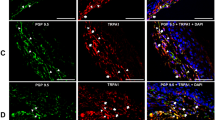Abstract
An isolated preparation of the cat tongue was developed to study quantitatively the relation between single cold receptor activity and calcium concentration. The activity recorded from lingual cold fibres of the isolated preparation was identical to that observed by previous authors in lingual cold receptors of whole animals. A perfusing solution containing excess calcium (5 mmol/l) suppressed discharge at constant temperatures as well as the dynamic response to rapid cooling. Reduced calcium levels (0.5 mmol/l) enhanced cold fibre activity at adapting temperatures above 15°C. Cold receptor activity was linearly inversely related to the logarithm of calcium concentration at adapting temperatures above 20°C. The linear relation was valid for both the discharge at constant temperatures and the dynamic peak frequency during cooling steps. From this relation it was calculated that at 25° C an elevation of 0.1 mmol/l external calcium above the control value (1.53 mmol/l) reduces static firing rate by 0.35 impulses per second. It is concluded that neither the in vitro conditions nor the application of various external calcium concentrations impair cold receptor function. The data are consistent with the hypothesis of a calcium-stimulated outward current controlling the static and dynamic response characteristics of cold receptors.
Similar content being viewed by others
References
Akaike N, Lee KS, Brown AM (1978) The calcium current of Helix neuron. J Gen Physiol 71: 509–531
Alm A, Bill A (1973) The effect of stimulation of the cervical sympathetic chain on retinal oxygen tension and on uveal, retinal and cerebral blood flow in cats. Acta Physiol Scand 88: 84–94
Altman PL, Dittmer DS (1974) Biology data book, vol III, Federation of American Societies for Experimental Biology, Bethesda, MD
Bade H, Braun HA, Hensel H (1979) Static burst parameters of lingual cold receptors in the cat. Pflügers Arch 382: 1–5
Benzing H, Hensel H, Wurster RD (1969) Integrated static activity of lingual cold receptors in the cat. Pflügers Arch 311 50–54
Braun HA, Bade H, Hensel H (1980) Static and dynamic discharge patterns of bursting cold fibres related to hypothetical receptor mechanisms. Pflügers Arch 386: 1–9
Dodt E (1953) The behaviour of thermoreceptors at low and high temperatures with special reference to Ebbecke's temperature phenomena. Acta Physiol Scand 27: 295–314
Duncan CJ (1981) The transducer mechanism of sense organs. In: Laverack MS, Cosens DJ (eds) Sense organs. Blackie, Glasgow, pp 100–111
Gola M, Selverston A (1981) Ionic requirements for bursting activity in lobster stomatogastric neurons. J Comp Physiol 145: 191–207
Gorman ALF, Thomas MV (1980a) Intracellular calcium accumulation during depolarization in a molluscan neurone. J Physiol (Lond) 308: 259–285
Gorman ALF, Thomas MV (1980b) Potassium conductance and internal calcium accumulation in a molluscan neurone. J Physiol (Lond) 308: 287–313
Greenleaf JE (1979) Hypothermia and exercise. In: Robertshaw D (ed) Environmental physiology III, International reviews of physiology, vol 20. University Park Press, Baltimore, pp 157–208
Greenleaf JE, Beaumont W Van, Brock PJ, Morse JT, Mangseth GR (1979) Plasma volume and electrolyte shifts with heavy exercise in sitting and supine positions. Am J Physiol 236: R206-R214
Hensel H (1973) Cutaneous thermoreceptors. In: Iggo A (ed) Handbook of sensory physiology, vol II. Springer, Berlin Heidelberg New York, pp 79–110
Hensel H (1976) Correlation of neural activity and thermal sensation in man. In: Zotterman Y (ed) Sensory functions of the skin. Pergamon, Oxford, pp 331–353
Hensel H (1981) Thermoreception and temperature regulation. Academic Press, London
Hensel H, Banet M (1982) Adaptive changes in cats after long-term-exposure to various temperatures. J Appl Physiol 52: 1008–1012
Hensel H, Schäfer K (1974) Effects of calcium on warm and cold receptors. Pflügers Arch 352: 87–90
Hensel H, Zotterman Y (1951) Quantitative Beziehungen zwischen der Entladung einzelner Kältefasern und der Temperatur. Acta Physiol Scand 23: 291–319
Legendre P, McKenzie JS, Dupouy B, Vincent JD (1985) Evidence for bursting pacemaker neurones in cultured spinal cord cells. Neuroscience 16: 753–767
Lux HD, Brown AM (1984) Patch and whole cell calcium currents recorded simultaneously in snail neurons. J Gen Physiol 83: 727–750
Lux HD, Hofmeier G (1982) Properties of a calcium-and voltage-activated potassium current in Helix pomatia neurons. Pflügers Arch 394: 61–69
Nielsen B (1974a) Actions of intravenous Ca2+ and Na+, on body temperature in rabbits. Acta Physiol Scand 90: 445–450
Nielsen B (1974b) Effect of changes in plasma Na+ and Ca2+ ion concentration on body temperature during exercise. Acta Physiol Scand 91: 123–129
Ottoson D, Swerup C (1982) Studies on the role of calcium in adaptation of the crustacean stretch receptor. Effects of intracellular injection of calcium, EGTA, and TEA. Brain Res 244: 337–341
Schäfer K (1985) Cold receptor activity quantitatively related to calcium concentration. Pflügers Arch 403: R52
Schäfer K, Braun HA, Hensel H (1982) Static and dynamic activity of cold receptors at various calcium levels. J Neurophysiol 47: 1017–1028
Schäfer K, Braun HA, Isenberg C (1986) Effect of menthol on cold receptor activity: Analysis of receptor processes. J Gen Physiol 88: 757–776
Swandulla D, Schäfer K, Lux HD (1986) Calcium channel current inactivation is selectively modulated by menthol. Neurosci Lett 68: 23–28
Swandulla D, Carbone E, Schäfer K, Lux HD (1987) Effect of menthol on two types of Ca currents in cultured sensory neurons of vertebrates. Pflügers Arch 409: 52–59
Tai CY, Smith QR, Rapoport SI (1986) Calcium influxes into brain and cerebrospinal fluid are linearly related to plasma ionized calcium concentration. Brain Res 385: 227–236
Uttal WR (1973) The psychobiology of sensory coding. Harper and Row, New York
Author information
Authors and Affiliations
Rights and permissions
About this article
Cite this article
Schäfer, K. A quantitative study of the dependence of feline cold receptor activity on the calcium concentration. Pflugers Arch. 409, 208–213 (1987). https://doi.org/10.1007/BF00584773
Received:
Accepted:
Issue Date:
DOI: https://doi.org/10.1007/BF00584773




